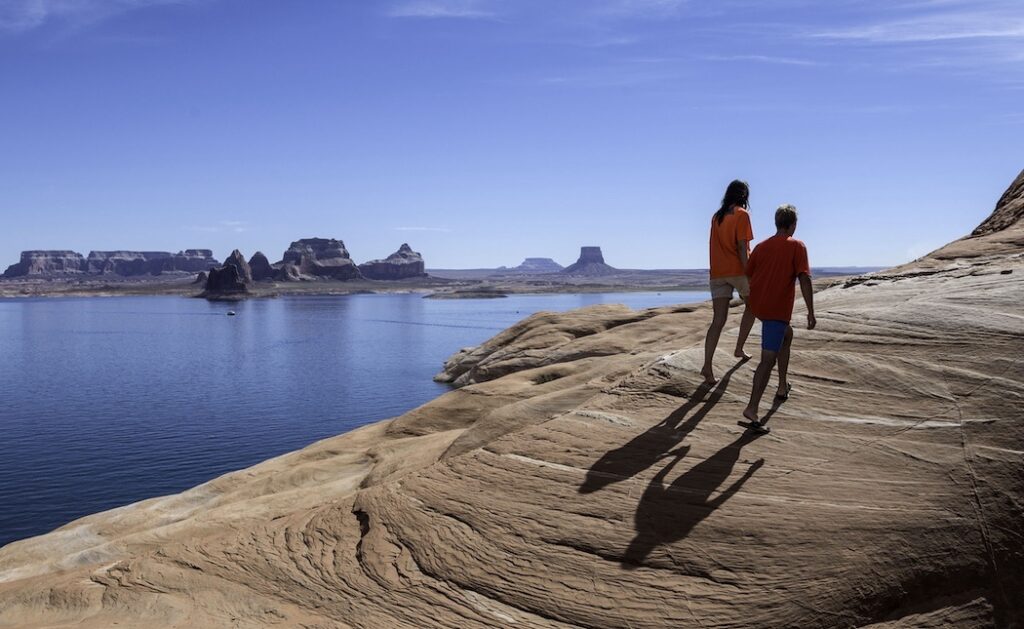
Hikers stroll the slickrock sandstone above Padre Bay, with Tower Butte on the horizon. Photo by Kerrick James
By Kerrick James
There is a yin ~ yang interplay of life and seasons in the corridors of sandstone canyons as the Colorado River makes its passage south through Utah, before being released below Arizona’s Glen Canyon Dam. Sometimes called the ‘American Nile,’ the great river of the American Southwest drops 9,010 feet from its headwaters in Colorado over its 1,450-mile journey to Mexico’s Sea of Cortez.
In the past, immense snowpacks blanketing the western slope of the Rocky Mountains slowly melted from spring well into mid-summer. Rivulets became cascades, with most runoff seeping into the earth, as springs and creeks coalesced. The river roared through Cataract Canyon south of Moab as the great lake, actually a reservoir, refills yet again. Lake Powell seesaws high and low, with wildlife more visible in winter.
Lake Powell is, at full pool, the second largest reservoir in the US, behind Lake Mead, with a surface area of 161,000 acres. It’s located on the Colorado Plateau, itself a sprawling 130,000 square miles of scenic high desert spanning parts of Arizona, Utah, New Mexico and Colorado. Lake Powell, and before it, Glen Canyon, is the watery heart of what locals call the Four Corners. With an average elevation of 5-7,000 feet, the Colorado Plateau has hot summers and cold winters, and much of its expanse stayed remote and nearly roadless until the Uranium boom of the 1950’s, and the opening of the Interstate 70 highway.
Retrenchment and Rebirth
Before the 710-foot concrete dam was completed in 1963, the Colorado River flowed freely through a remote wilderness known as Glen Canyon, named by geologist John Wesley Powell on his historic 1869 journey south through what now is called the Grand Canyon. Lake Powell reached ‘full pool’ in 1980, and was last brimful in July of 1983, when the dam came perilously close to breaching. That distant dangerous summer seems improbable today, as the Southwest has been drying out since at least 2008, with much diminished snowfall and rain runoff due to the Millennium Drought, the most severe in 1,200 years. Lake Powell is currently less than 30% of normal capacity and is over 150 feet below full pool as of late summer 2025. But could there be a silver lining to our great Southwestern drought, at least for those thirsting for adventure and rediscovery? Many believe so since dozens of hidden canyons, caves, and ‘glens’ are once again visible and accessible to new explorers. Glen Canyon is revealed and reborn, even as Lake Powell’s waters diminish. Here’s how to make the most of your adventure.
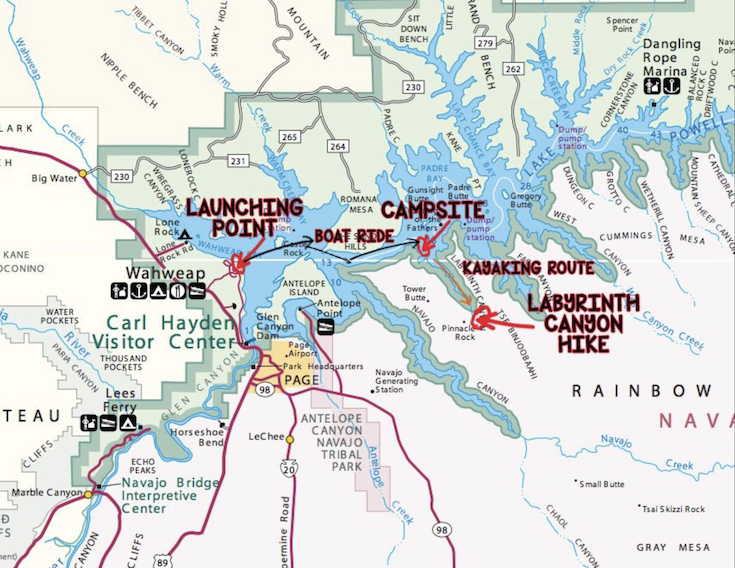
Narrow canyon lakes and bays radiating off the Southern portion of Lake Powell close to Page, AZ and the Glen Canyon Dam. Rainbow Bridge, Bullfrog Visitor Center and areas accessible from Moab, UT are east of the area depicted.
Anchors Aweigh
Although most of Lake Powell lies within Utah borders, Arizona claims it as well. Page, Arizona (pop. 7,200) is the ideal place to begin your exploration of Glen Canyon. It has excellent tourism services that include extensive powerboat, houseboat and small watercraft rentals. At this time launching motorized private boats is restricted to the Stateline Auxiliary Ramp, so presently you may have to rent a boat to explore the lake. Powerboats are rented by the day or longer but have limited space. Houseboats offer vastly greater comfort for extended overnight trips (think air conditioning, full kitchens, hot tubs, water slides, TV) but use much more fuel (at $6-7/gallon) and require some skill to drive, maneuver and anchor. Tutorials are available. You’ll also likely want either a powerboat or jet skis (both towed behind your houseboat) to venture into the 96 myriad side canyons, many of them too tight for a houseboat.
Two large boat rental companies, based at Wahweap and Antelope Point marinas, offer optional Pilot/Captain service to help drive and anchor their houseboats where you choose and, while a bit pricey, that peace of mind is invaluable, especially in low water conditions.
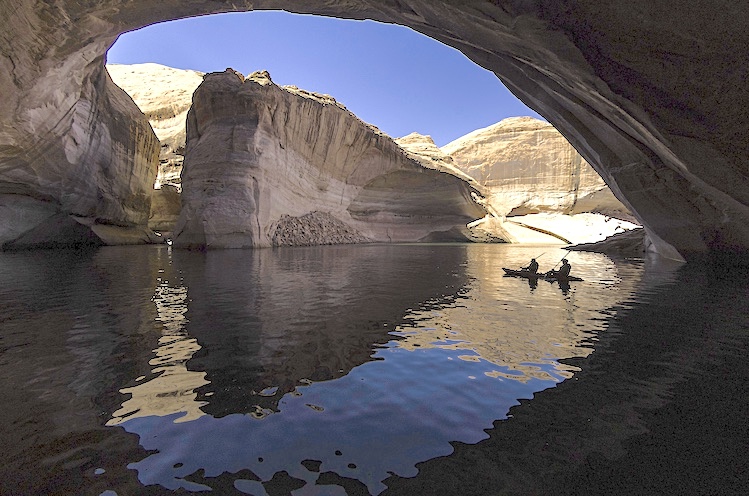
Kayakers skim the surface of the pool inside Cathedral in the Desert. Photo by Kerrick James
Think of a houseboat as your movable base camp, anchored for several nights in multiple scenic locations around the lake, using it to leisurely explore nearby sites like Rainbow Bridge, Gunsight Butte, Reflection Canyon, Defiance Ruin, and dozens more.
Start Your Houseboat Trip
Before you start your lake trip, you can spend the night and rent your choice of watercraft at Wahweap, west of Page, at the Lake Powell Resort and Marina. Their houseboats are 46 to 75 feet in length, with generous amenities and a choice of bedroom configurations. Antelope Point Marina, a few miles east of Page on the Navajo Reservation, also offers an array of quality houseboats from 59 to 77 feet in length, plus pontoon and deck boats. They have a good restaurant and store on their floating marina. TIP* Don’t forget to bring or rent a kayak or two. They are a cheap and quiet way to experience the peace and Zen of the emerging Glen Canyon riparian ecosystem. I’d never venture out on the lake without a kayak, as paddling through narrow slot canyons is one of the greatest pleasures of Lake Powell, and Glen Canyon.
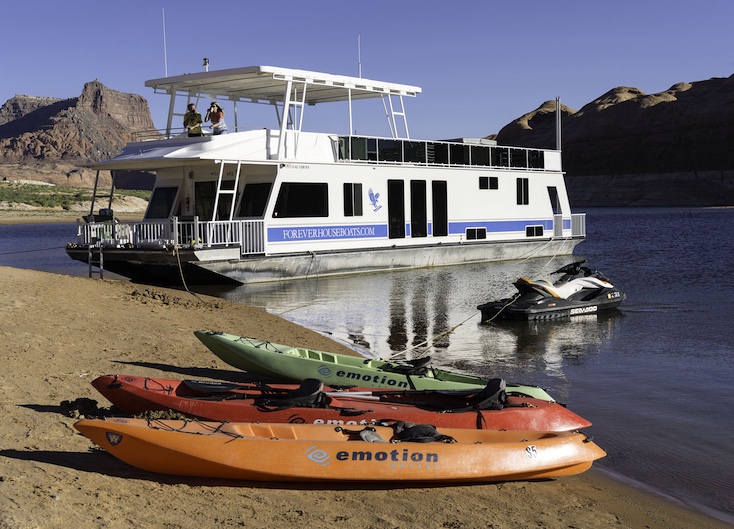
Travelers on a houseboat can anchor in places like Oak Canyon and then explore the area on kayaks or more nimble motorized craft. Photo by Kerrick James
Houseboat Alternatives
While I love the comfort of a houseboat, I ultimately prefer to camp on whatever beach catches my fancy late in the day. Renting a smaller watercraft allows you to keep your options open. However, you must carry all the essentials for cooking, sleeping and exploring. Consider renting a 23-ft. to 28-ft. powerboat, which offers good fuel economy and is far cheaper than a houseboat.
There is no longer a mid-lake gas station since Dangling Rope Marina was destroyed by a monsoon windstorm several years ago. Bring at least 20 gallons of extra fuel to prevent range anxiety if you need to reach Bullfrog Marina at Mile 94 or return to Antelope Point. The National Park Service does not bring fuel if you run out, but you can call 911 for other emergencies or use Marine Channel 16. There is scattered cell coverage on the lake, usually in line of sight with 10,000-ft. Navajo Mountain, but don’t count on it everywhere. The NPS Emergency number is 928-608-6300. Lastly, for a different kind of emergency, floating outhouses are scattered around the lake, so cruise alongside, tie up, and leave refreshed.
When you depart from either Wahweap or Antelope Point marinas you’ll essentially be cruising northeast, past Antelope and Navajo Canyons, both in Arizona. But every watery mile beyond them is in Utah. Glen Canyon Dam is Mile 0 for reference. Houseboats move at a leisurely pace, so plan on taking several hours to motor up the lake to Padre Bay (Mile 23), Last Chance Bay (Mile 28), or Rock Creek Bay (Mile 36). All offer superior beaches for camping. Lake Powell has two very notable tributaries that beg to be explored. The closest one to Page is the longish San Juan River Arm, starting at Mile 57. The Escalante River Arm, at Mile 68, is much smaller in length and flow, but easily wins over the San Juan in scenic beauty.
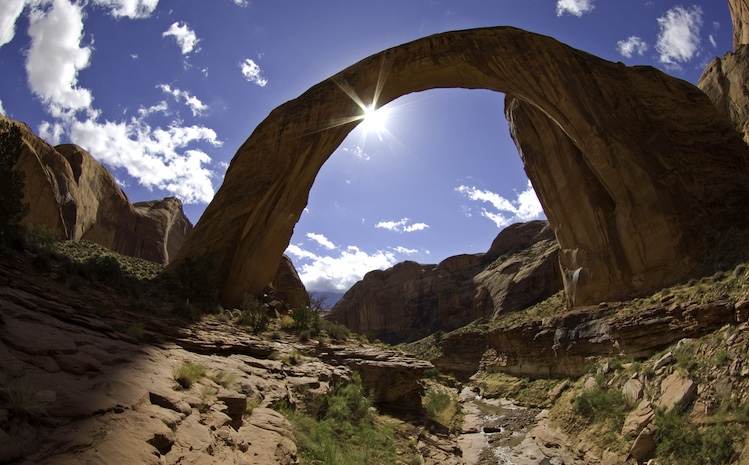
Rainbow Bridge is about a half-mile stroll from the boat dock, on a good wide trail. Take some quiet time underneath the 290-ft. high and 275-ft. wide span of Kayenta sandstone, the largest natural bridge on the planet. Photo by Kerrick James.
Perils Of Diminished Water Levels
At these low water levels, perils can sneak up very quickly, as did the sudden spire of sandstone in the Escalante Arm that bent my propeller as we left Cathedral in the Desert in 2022. Two inches lower and we’d have been stranded with a broken engine, yet an inch or two higher and we’d have just missed it and never known how close we’d been to sheared metal. We’d been cruising in 220 ft of water and abruptly we were in 3 ft, without warning. Always have a spotter in the bow and be ready to slow and lift your prop! The lesson here is that the NPS has only marked some of the known older shoals, and it’s up to you to find any new perils.
If you like to swim comfortably, float languidly in a kayak or paddle a stand-up paddle board along the shore, plan your Lake Powell trip from mid-summer to autumn, roughly July to mid-October. Yes, there will be more people on the water, but it’s a spacious lake and swimming will be much more enjoyable. One February, I explored the lake at very low water in a 23-foot pontoon boat, beach camping wherever we pleased, but it was below freezing at night, and swimming was impossible without a wetsuit. Mid-summer air temps can hit triple digits, so water temps in the 80s are near perfect. Nights cool off well due to the dry, high desert atmosphere that is perfect for stargazing, bonfires on the beach, and a good night’s sleep.
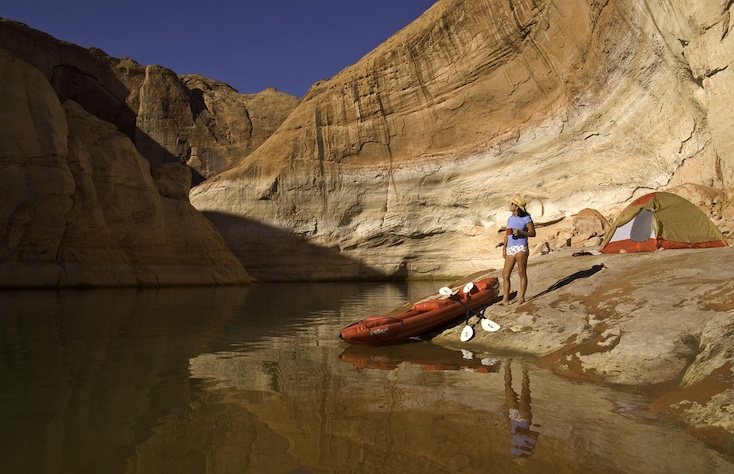
Camping and kayaking go together in Davis Gulch, Escalante Arm, Glen Canyon National Recreation Area. Photo by Kerrick James
Page Is Heart Of The Action
Many visitors touring Arizona fly into Phoenix and then drive 275 miles north to the Grand Canyon, usually the South Rim. From there, it’s a scenic 136 miles to Page, about 2 ½ hours, to start their Lake Powell/Glen Canyon experience. Driving directly from Phoenix to Page will take close to 5 hours. Yes, even if you have just a week to roam, you can get out on the lake itself and also explore many spectacular local sites, as Page bills itself as the Center of Adventure. You’ll surely want to see some of the most famous slot canyons in the world, starting with Upper and Lower Antelope Canyon, Cardiac Canyon, Secret Canyon (best for photography), and then stroll at sunset around the cliff edges at Horseshoe Bend, 800 feet above the river. Be careful —the view is distracting!
Downriver from the dam, 30 minutes from Page, is Lee’s Ferry, where Grand Canyon rafting expeditions put into the Colorado River. If you fish, there’s also a world-class trout fishery at your feet. An hour due west from Page is the famous Wave, a five-mile round-trip day hike into kaleidoscopic twisting sandstone layers that requires a hiking permit, which you may be able to secure in Page. Research this in advance. There’s so much to do around Page, you’ll be back…
Ninety-four miles up the lake from Glen Canyon Dam (Mile 0), or five hours by road from Page, is Bullfrog, home to a marina with fuel, provisions, and light services. You can also rent a houseboat or pontoon boat here, but reservations are essential. Bullfrog is also just a couple of hours’ drive from three national parks —Arches, Canyonlands, and Capitol Reef —so a combo trip is easily arranged. There is an airport just outside Moab, so it is possible to enter the Lake Powell/Glen Canyon area from the Utah side.
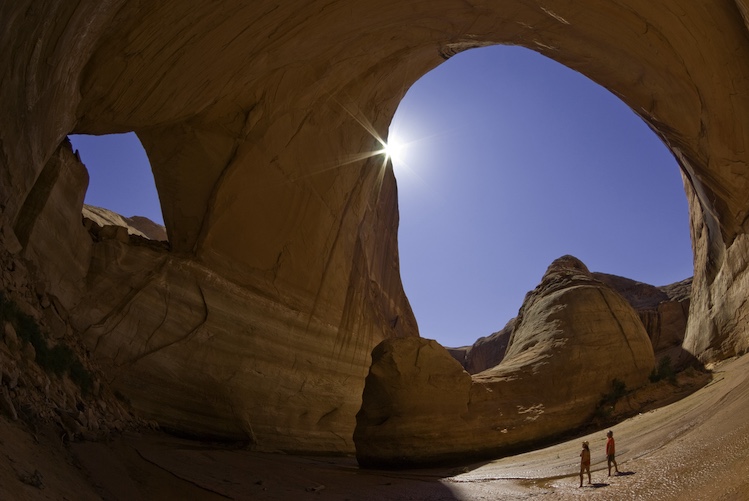
La Gorce Arch typifies the arid majesty of the Lake Powell region in Arizona and Utah. Photo by Kerrick James
Poetic Names From A Civil War Veteran
Geologist John Wesley Powell and his intrepid crew named many features in Glen Canyon, bestowing poetic and insightful titles like Music Temple, Lost Eden, Hidden Passage, Dungeon and Labyrinth, but a personal favorite of mine, Cathedral in the Desert, was named in 1954 by two more modern explorers, Burnett Hendrix and Harlon Beamont. It’s a protected space with marvelous acoustics, and for decades has been a hidden alcove pool, seemingly suspended in space, where one can kayak in solitude.
In February of 2022, I boated to within a half mile of Cathedral in the Desert – as far as I could go – and then hiked into this expansive alcove where the lake was down 150 ft or so. One drawback of the low water is the deep sediment layer that must be traversed to reach solid rock. I lost one pair of good boots to the sticky muck, literally pulled off my feet as I struggled to get from my boat to shore. On prior visits, at much higher water, the still waters half-filled the 250-ft-high space enveloped by Navajo sandstone, lapping at the top edge of a wispy waterfall chute. Rounding the bend on that cold winter’s day revealed a great open space edged by a sloping sand dune and a shallow reflection pool, where I could hear a slender thread of water falling, a tinkling liquid chord. The only other sound was my heartbeat, hidden deep in the Escalante River arm, the veritable heart and soul of Glen Canyon.
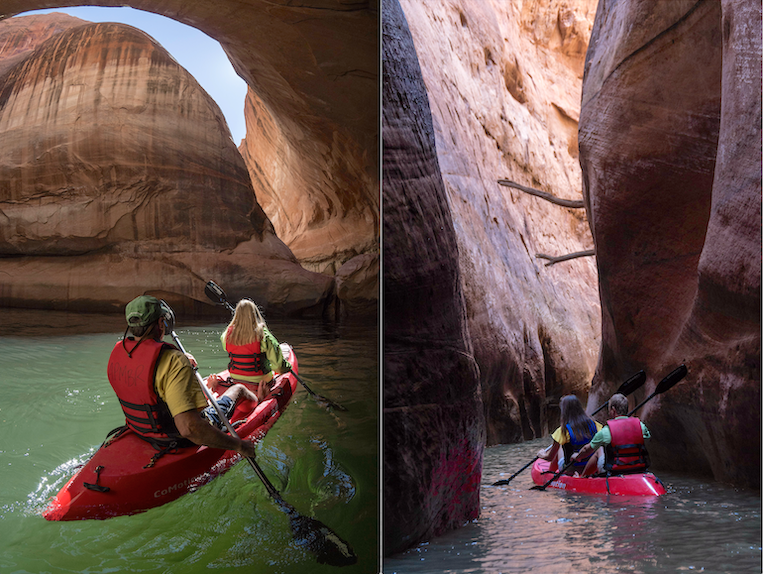
Kayakers explore Cathedral in the Desert (left) and Secret Canyon. Where is “Secret Canyon” given the enormity of Lake Powell? Ask at one of the marinas and they will tell you. Or you can peruse “Lake Powell and its 96 Canyons – Boating & Exploring Map.” Photos by Kerrick James
Exploration Without End
You would need dozens of trips to Lake Powell and its emergent twin, Glen Canyon, to explore every canyon, cove, cave, arch, archaeological ruin, petroglyph site, and spire. I’ve made perhaps twenty trips here since the flood summer of 1983, seen the lake at full pool and 170’ below it, yet I know I’ll never see it all. And that is why I return, to fill in the blanks while the canyon fills my soul. My pictures save the moments, but only of just one day, while the living, breathing heart of Glen Canyon is ever changing, ever keyed to water falling and flowing on a dry desert plateau.
TIPS & PLANNING
Buy the map ‘Lake Powell and Its 96 Canyons ~ Boating & Exploring Map’ At $5 it’s a wise investment.
You can rent pontoon boats and powerboats from the Lake Powell Vacations office in Page, or at the Wahweap boat launch. Also, at Antelope Point Marina
All of the Arizona boat rental establishments mentioned above have fuel as well as kayak rentals. Note that the Antelope Point Marina is on Navajo Tribal lands and may be in a different time zone.
Several companies rent boats and sell gasoline at Bullfrog Marina (Mile 94+).
Page has a fine range of motels and hotels, including several new properties. You can buy all your provisions in Page, which has a big Safeway and Walmart.
Lake Powell is the heart of the Glen Canyon National Recreation Area, administered by the National Park Service. If you don’t have the NPS Annual Pass, you’ll pay $35 at the gate.
Track Lake Powell’s current water level at: https://lakepowell.water-data.![]()
Arizona travel journalist Kerrick James was named the 2020 Travel Photographer of the Year. He teaches photography workshops, has rafted the Grand Canyon 18 times and recently explored Route 66 and America’s western ghost towns for the East-West News Service.

